Keras入门教程 6.Keras 预训练模型应用
Keras 入门教程
- 1.线性回归建模(快速入门)
- 2.线性模型的优化
- 3.波士顿房价回归 (MPL)
- 4.卷积神经网络(CNN)
- 5.使用LSTM RNN 进行时间序列预测
- 6.Keras 预训练模型应用
Keras 预训练模型应用
Keras 应用模块用于为深度神经网络提供预训练模型。Keras 模型用于预测、特征提取和微调。本节详细介绍了 Keras 应用程序。
预训练模型
训练好的模型由模型架构和模型权重两部分组成。模型权重是大文件,因此我们必须从 ImageNet 数据库下载并提取特征。下面列出了一些流行的预训练模型:
- ResNet
- VGG16
- MobileNet
- InceptionResNetV2
- InceptionResNetV3
加载模型
from keras.applications import vgg16, inception_v3, resnet50, mobilenet
#Load the VGG model
vgg_model = vgg16.VGG16(weights = 'imagenet')
#Load the Inception_V3 model
inception_model = inception_v3.InceptionV3(weights = 'imagenet')
#Load the ResNet50 model
resnet_model = resnet50.ResNet50(weights = 'imagenet')
#Load the MobileNet model
mobilenet_model = mobilenet.MobileNet(weights = 'imagenet')
加载模型后,我们可以立即将其用于预测目的。让我们在接下来的章节中检查每个预训练模型。
ResNet是一个预训练模型。它使用 ImageNet 进行训练。在 ImageNet 上预训练的 ResNet 模型权重。它具有以下语法:
keras.applications.resnet.ResNet50 (
include_top = True,
weights = 'imagenet',
input_tensor = None,
input_shape = None,
pooling = None,
classes = 1000
)
- include_top 指的是网络顶部的全连接层。
- weights 指的是 ImageNet 上的预训练。
- input_tensor 指用作模型的图像输入的可选的 Keras 张量。
- input_shape 指可选的形状元组。此模型的默认输入大小为 224x224。
- clasees 指用于对图像进行分类的可选数量的类。
让我们通过写一个简单的例子来理解模型:
第 1 步:导入模块
加载如下指定的必要模块:
import PIL
from keras.preprocessing.image import load_img, image
from keras.preprocessing.image import img_to_array
from keras.applications.imagenet_utils import decode_predictions
import matplotlib.pyplot as plt
import numpy as np
from tensorflow.keras.applications import vgg16, inception_v3, resnet50, mobilenet
import matplotlib.pyplot as plt
%matplotlib inline
第 2 步:选择一个输入
选择一个输入图像,网上找了一张图片,如下所示:
filename = 'pp8.png'
original = load_img(filename, target_size = (224, 224))
print('PIL image size',original.size)
plt.imshow(original);
在这里,我们加载了一个图像并显示了它。
第 3 步:将图像转换为 NumPy 数组
将输入的 Banana 转换为 NumPy 数组,以便将其传递到模型中以进行预测。
# 将图 转 numpy 数组
numpy_image = img_to_array(original)
plt.imshow(np.uint8(numpy_image))
print('numpy array size',numpy_image.shape)
# 将图转 图的批量格式
image_batch = np.expand_dims(numpy_image, axis = 0)
print('image batch size', image_batch.shape)
numpy array size (224, 224, 3)
image batch size (1, 224, 224, 3)

第 4 步:模型预测
将输入输入模型以获得预测
# 为 resnet50 模型 格式
processed_image = resnet50.preprocess_input(image_batch.copy())
# 创建 resnet 模型
resnet_model = resnet50.ResNet50(weights = 'imagenet')
# 获得 预测可能分类
predictions = resnet_model.predict(processed_image)
输出
# 转化为可能分类标签
label = decode_predictions(predictions,top=1)
print(label)
[[(‘n02676566’, ‘acoustic_guitar’, 0.98159516)]]
# 换另张图
filename = 'ba.png'
original1 = load_img(filename, target_size = (224, 224))
print('PIL image size',original1.size)
plt.imshow(original1)
numpy_image1 = img_to_array(original1)
plt.imshow(np.uint8(numpy_image1))
print('numpy array size',numpy_image1.shape)
image_batch1 = np.expand_dims(numpy_image1, axis = 0)
print('image batch size', image_batch1.shape)
processed_image1 = resnet50.preprocess_input(image_batch1.copy())
predictions1 = resnet_model.predict(processed_image1)
label = decode_predictions(predictions1,top=1)
print(label)
[[(‘n07753592’, ‘banana’, 0.99918777)]]
换其他模型
VGG16
VGG16 是另一个预训练模型。它还使用 ImageNet 进行训练。加载模型的语法如下:
keras.applications.vgg16.VGG16(
include_top = True,
weights = 'imagenet',
input_tensor = None,
input_shape = None,
pooling = None,
classes = 1000
)
此模型的默认输入大小为 224x224。
MobileNetV2
MobileNetV2 是另一个预训练模型。它也是使用ImageNet 进行训练。 加载模型的语法如下:
keras.applications.mobilenet_v2.MobileNetV2 (
input_shape = None,
alpha = 1.0,
include_top = True,
weights = 'imagenet',
input_tensor = None,
pooling = None,
classes = 1000
)
alpha控制网络的宽度。如果该值低于 1,则减少每层中的过滤器数量。如果该值大于 1,则增加每层中的过滤器数量。如果 alpha = 1,则在每一层使用纸张的默认过滤器数量。
此模型的默认输入大小为224x224。
InceptionResNetV2
InceptionResNetV2 是另一个预训练模型。它也是使用ImageNet 进行训练。加载模型的语法如下:
keras.applications.inception_resnet_v2.InceptionResNetV2 (
include_top = True,
weights = 'imagenet',
input_tensor = None,
input_shape = None,
pooling = None,
classes = 1000)
此模型可以使用“channels_first”数据格式(通道、高度、宽度)或“channels_last”数据格式(高度、宽度、通道)构建。
此模型的默认输入大小为299x299。
InceptionV3
InceptionV3 是另一个预训练模型。它也是使用ImageNet 进行训练。加载模型的语法如下:
keras.applications.inception_v3.InceptionV3 (
include_top = True,
weights = 'imagenet',
input_tensor = None,
input_shape = None,
pooling = None,
classes = 1000
)
此模型的默认输入大小为299x299。
#Load the VGG model
vgg_model = vgg16.VGG16(weights = 'imagenet')
#Load the Inception_V3 model
inception_model = inception_v3.InceptionV3(weights = 'imagenet')
#Load the MobileNet model
mobilenet_model = mobilenet.MobileNet(weights = 'imagenet')
vgg16_image = vgg16.preprocess_input(image_batch1.copy())
inception_image = inception_v3.preprocess_input(image_batch1.copy())
mobilenet_image = mobilenet.preprocess_input(image_batch1.copy())
pred_vgg16 = vgg_model.predict(vgg16_image)
label = decode_predictions(pred_vgg16,top=1)
print(label)
[[(‘n07753592’, ‘banana’, 0.9616605)]]
pred_mobilenet = mobilenet_model.predict(mobilenet_image)
label = decode_predictions(pred_mobilenet,top=1)
print(label)
[[(‘n07753592’, ‘banana’, 0.9993032)]]
由于inception_v3模型默认的大小是299*299,因此图片重新处理,并归一化,使得分类效果更加明显。
img = image.load_img("ba.png", target_size=(299, 299))
input_image = image.img_to_array(img)
input_image /= 255.
input_image -= 0.5
input_image *= 2.
# Add a 4th dimension for batch size (Keras)
input_image = np.expand_dims(input_image, axis=0)
# Run the image through the NN
predictions = inception_model.predict(input_image)
# Convert the predictions into text
predicted_classes = inception_v3.decode_predictions(predictions, top=1)
predicted_classes
[[(‘n07753592’, ‘banana’, 0.99996054)]]

